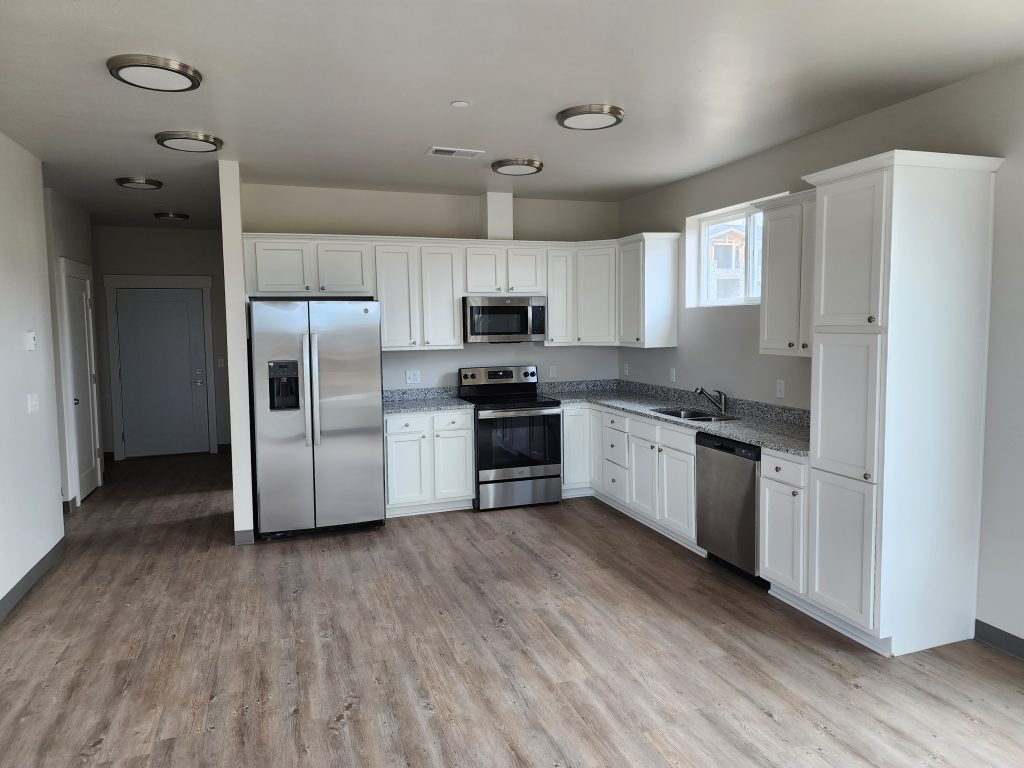Affordable housing project searches for applicants who qualify financially

Meg Soyars/Sky-Hi News
Editor’s Note: This story has been updated to clarify how the AMI of each apartment unit is designated.
“We need more affordable housing” is a long-standing mantra in Grand County. This mantra comes from all sides – from state legislators making campaign stops, to town trustees, to residents working to make ends meet.
Yet affordable housing projects can’t keep up with demand, notably for the lowest wage earners. The Mill Apartments near Fraser is one of the few low-income housing projects in Grand County since 1995.
Just as affordability is a challenge in the county, The Mill Apartments project has faced its own challenges. Community members have encountered difficulties during the application process. On the other side of the coin, the developer and property management company have struggled to fill units reserved for those at the lowest incomes.
Here is an explanation of the project and how the application process – designed to ensure the most vulnerable receive housing – can sometimes hit roadblocks.
What is LIHTC housing?
From 2021 until now, residents have watched construction of the project at the corner of Mill Avenue and Leonard Lane. The Mill Apartments includes two three-story buildings of 60 units, plus a clubhouse and community area. While these buildings look similar to other new condos around Fraser, they aren’t market rate. Unlike market rate apartments, the application process for The Mill’s potential tenants is intensive.
This is because the apartments received a Low-Income Housing Tax Credit, also known as LIHTC, by The Colorado Housing and Finance Authority (CHFA). The project is government subsidized.
“For The Mill Apartments, the terms stipulate that tenants must be full-time Grand County residents who earn 30% to 80% of the area median income,” Clark Lipscomb, the apartment’s developer, told Sky-Hi News. “The formula gets even more specific.”
The developer designates each apartment unit at a certain area median income, known as a matrix, with the bulk being at 50% AMI. Below is the matrix table.
| Percentage of AMI | # of units available | 1 bed | 2 bed | 3 bed | Rent per bedroom |
| 30% | 8 | 3 | 3 | 2 | $525 / $630 / $727 |
| 40% | 7 | 2 | 3 | 2 | $700 / $840/ $970 |
| 50% | 18 | 6 | 8 | 4 | $875 / $1,050 / $1,213 |
| 60% | 13 | 6 | 5 | 2 | $1,050 / $1,260 / $1,455 |
| 70% | 10 | 5 | 4 | 1 | $1,225 / $1,470 / $1,698 |
| 80% | 4 | 2 | 1 | 1 | $1,401 / $1,680 / $1,941 |
“The LIHTC regulations require a project to be 60% of AMI or below average,” Lipscomb explained.
Once the specific matrix has been filled, The Mill must maintain an overall average of 53.77% AMI. So as tenants move out and new tenants arrive, the apartments remain affordable.
Several entities must be involved to get a LIHTC project off the ground. The apartments are part of the Grand Park community, developed by Lipscomb.
According to Lipscomb, Grand Park is the only local “private sector, free market-driven company” that has created low-income housing for the workforce in the county.
The Denver-based property management firm Ross Envolve handles the application process. Ross is one of the few firms that handles LIHTC projects in mountain communities. Midwest Housing Equity Group of Nebraska oversees the process. Lastly, the Grand County Housing Authority is a limited partner.
When community members want to move into The Mill, their first step is to fill out an application through Ross Envolve to confirm their income. This is where challenges can arise.
Residents feel lost in application process
Sky-Hi News has heard from several community members who had difficulty with their applications for The Mill. Their excitement at finally finding a home they could afford turned to frustration because of the long application process. Two community members wished to remain anonymous, since their families are still working through the process.
Sky-Hi News can’t share the experiences of anonymous individuals, but community member Rachel Leiser gave her experience.
Leiser and her boyfriend began the application process with hopes to move into an apartment in November. Ross sent her application back twice to confirm missing income information. The second time the application was sent back, Leiser was confused by one of the questions and emailed Ross several times for clarification. No one responded back to her, Leiser said.
Similarly, the staff at Grand Seniors found it difficult to arrange housing at The Mill for two of their senior clients. Grand Seniors is part of the nonprofit Mountain Family Center. Missy Posey, transportation coordinator for Grand Seniors, helped the seniors through the application process. Despite long delays, the two finally were approved for housing this October. Katie Stuvel, Mountain Family Center’s community programs manager, confirmed that one senior has already moved and is happily settling in her new home.
Other residents applying to The Mill Apartments have had their applications rejected. In a county where demand for affordable housing is high and inventory is low, why has Mill Apartments faced challenges? The answer lies in part with strict CHFA regulations.
Checking and double checking
To ensure each resident earns between 30-80% AMI, there are lots of steps before approval or denial.
The area median income in Grand County is $65,400 for an individual. For a family of four, AMI is $93,300. At the affordable housing development Fireside Creek, a person making between $52,320-$78,480 a year qualifies. For The Mill Apartments, a person making $19,670-$52,320 a year qualifies.
“This isn’t like applying for a normal, free market long-term rental apartment where there’s no restrictions,” Lipscomb said. “… CHFA is following IRS regulations.”
Because the tax credits are allocated by the IRS to state organizations (like CHFA), everyone involved must “check a lot of boxes” to ensure the project is done right, Lipscomb added.
When an applicant applies through Ross, the first box to check is a background check. Once applicants pass this, Ross moves to the most intensive step.
“We have to work to get all third-party verifications of any forms of income or assets that they have, because of income restrictions,” said Brooke Parra, co-president of Ross Envolve.
This includes getting documents from employers. After Ross completes their verification, they send the application to Midwest Housing Equity Group. Midwest is the tax credit investor, so they also thoroughly review the application.
All the steps are to verify “the homes are going to people who qualify,” stated Lipscomb. “After that verification, the lease can be signed, and an applicant becomes a tenant – and can move in.”
Unfortunately, not everyone who applies is guaranteed an apartment. Some community members who have applied or attended one of the open houses have been turned down because their income is too high.
For example, during the employment verification section of the application, Ross may discover the person is over-income. What happens then? Christine Travis, the county’s communications director, explained that some applicants are given bad news. They either must wait for an apartment that matches their income to become available, or they may be completely disqualified.
“It’s also imperative that applicants provide full, accurate information on their application,” Travis stated. “It’s our understanding that it is taking time to resolve missing or inaccurate information that is discovered during compliance reviews.”
The Mill has income limits that are significantly lower than any other recent affordable housing development. For example, Fireside Creek in Winter Park is deed-restricted to those making between 80%-120% AMI. Victoria Village, another project coming to Fraser, will have some units reserved for residents earning 120% AMI or less. Koeslig on Main in Fraser has two units restricted at 80% AMI, with the rest renting for market rate.
For applicants of The Mill apartments who are at 80% AMI, they may have been denied because there are only four units at 80% available. CHFA designates the number of units.

Another challenge for tenants was the wait for Certificates of Occupancy (CO) to be issued by the county for their particular unit.
“It’s been a moving target given the (construction) workforce, supply chain issues, etcetera,” Lipscomb said. “… Our original goal was to have COs by July, then it slipped to August. We got some in September and here we are … now in October, we’re getting the rest of them.”
In addition to construction delays, The Mill also must adhere to federal fair housing laws, such as the Americans with Disability Act. Once county commissioners finally confirmed the units were move-in ready and followed all laws, they began to issue COs in early September. The COs were issued in phases, with one building planned six weeks behind the first.
Although all COs have now been issued, there is still one final hurdle – filling the units. This proved harder than expected.
‘Collecting dust’
Lipscomb stated it has been a struggle finding tenants at the 30-60% AMI range, although overall demand for units has been high because of the county’s lack of longterm rentals. Community members have seen that affordable housing is available and eagerly applied. Travis stated that although the lower income units were to be occupied first, Ross recently received approval from CHFA to begin leasing higher-income units.
The apartments must be 95% occupied by Dec. 31, then maintain this occupancy for 90 days. If that doesn’t occur, then the tax credit funds are not issued. This means that the deed restriction falls away. There’s a risk the units could become market rate. However, Lipscomb stated in an August meeting with the town of Fraser he’d continue working with the county’s housing authority to keep some units affordable.
Because the units must be occupied to retain deed restriction, “it’s critical and urgent” that those making below 60% reach out to The Mill if they are searching for housing, Lipscomb said.
“The best thing … for everyone is for this to work the way it was set up and intended and that’s what we’ve been endeavoring to do,” he explained.
As of Oct. 23, only 12 tenants have moved in. There are 25 potential tenants in the application process, and eight tenants have been approved, awaiting lease signing. Of these, two are Grand Park employees, said Lipscomb. There are 15 units without any applicants.
The struggle to find low-income applicants may be in part to Grand’s small population, according to Lipscomb. The 2020 census stated that 15,717 people live in Grand County. In contrast, LIHTC housing projects can fill up more quickly in urban areas, such as Denver.
“To see those apartment units sitting there empty and collecting dust when the community clearly has a need for long-term rental housing is disturbing to say the least,” Lipscomb stated.
A new home for those who qualify
For those who can move into The Mill, one, two or three-bedroom apartments are available. Lipscomb explained he built the apartments with the same amenities a market rate apartment has.
“They’re nice,” he said. “There’s several people living over there that I always ask, how is it? And they seem really happy.”

Each apartment has a balcony, full kitchen and in-unit washer/dryer. Pets are allowed, and the property is non-smoking. The clubhouse will include a pool table, coffee station and loft.
The project also accepts people with Section 8 Housing Choice vouchers. Currently, the only other local housing which accepts Section 8 is Fraser’s Wapiti Meadows, built in 1995. Their deed restriction will expire in 2025.
“If they have their own voucher already through the (Grand County) Housing Authority, and they want to move, they can reach out to us,” Parra said. “… That’s why CHFA believes in doing new construction, because it’s an opportunity to live in a great place for you and your family.”
Ross has recently hired an on-site property manager to assist them, who is currently available to give tours of the units. Community members can visit mill-apartments.com to download the application or view photos of the units. Those needing help filling out their applications can reach out for assistance.
Travis stated that the county’s housing authority operations manager, Sheena Darland, doesn’t have an official role at The Mill, “but has stepped in unofficially to help fill some communication gaps and ensure applicants understand the status of their application.”
Darland can be reached at 970-725-3070 or sdarland@co.grand.co.us. Ross Envolve can be reached at 303-860-7885 or info@mill-apartments.com. Lipscomb added that people can also reach out to Grand Park at 970-726-8600, or stop by the office.
“We don’t want to have any impediments for somebody not to get their information over,” he said.
In a rural resort community like Grand County, some residents feel as if an affordable home is out of reach. Housing insecurity creates ripple effects across the county, from a lack of workforce to a proliferation of vacation homes. Despite challenges felt by both applicants and those in charge of the project, The Mill Apartments offers some of the most affordable units in Grand for those who qualify.
Lipscomb and Parra added that the goal of the project is to help current residents find stable, long-term housing. So even if a resident at The Mill receives an increase in income that’s above their original AMI, they can still live at the apartments for as long as they want to.

“The goal is not to keep the poor, poor,” said Lipscomb. “The goal is to help people improve their quality of life.”
The Grand Park office is located at 46 Market Street in Fraser. The Grand County Housing Authority is at 612 Hemlock Street in Hot Sulphur Springs.
Grand Park very much wants The Mill Apartments community to succeed and achieve the goal of providing needed affordable housing to this area …
I think the nearly six-month effort trying to find applicants that qualify for this 30%-80% AMI low income housing has proven the need is not actually low income; rather, long term rental housing is what the community need really appears to be based on the number of over income interested parties that have inquired about the property but were turned away due to their income level.”

Support Local Journalism

Support Local Journalism
The Sky-Hi News strives to deliver powerful stories that spark emotion and focus on the place we live.
Over the past year, contributions from readers like you helped to fund some of our most important reporting, including coverage of the East Troublesome Fire.
If you value local journalism, consider making a contribution to our newsroom in support of the work we do.










